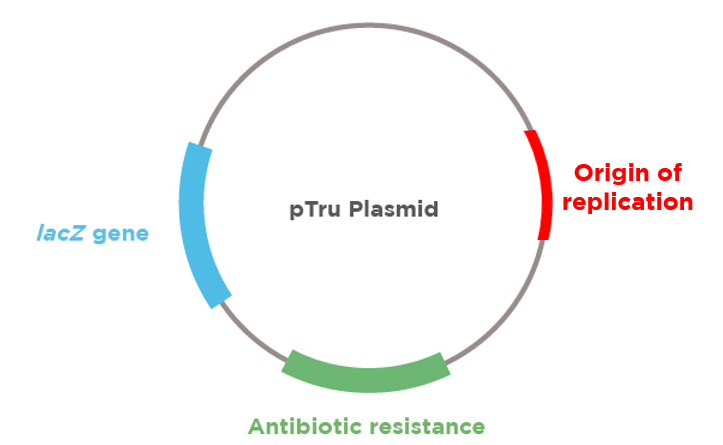What is a plasmid? Three key components
Plasmids are small, circular pieces of DNA often found naturally in bacteria and other microorganisms. Independent from the bacterial chromosome, plasmids replicate autonomously and exist in multiple copies inside the host cell. Plasmids often contain genes that provide beneficial traits for the organism, for example antibiotic resistance.
In molecular biology laboratories, plasmids can serve to introduce DNA into cells through a process known as bacterial transformation. Once the plasmid is inside a cell, its DNA sequence will be copied many times. Any genes encoded by the plasmid may be expressed by the host cell too.

Because they can carry, multiply, and even express DNA sequences of interest, we often refer to plasmids as genetic vectors. To serve their purpose as vectors of genetic information, plasmids must have:
- An origin of replication: Plasmids are copied by the DNA replication machinery of the host cell. The site on the plasmid where DNA polymerase starts DNA replication is known as the origin of replication.
- A selectable marker: Plasmids typically carry at least one gene that enables growth in adverse conditions, conferring an advantage to the host cell. For example, resistance genes that allow cells to grow in the presence of antibiotics. We call these genes selectable markers because they allow scientists to specifically select for cells that carry the plasmid, for example by adding antibiotics to the growth media such that only cells with the plasmid will survive.
- DNA sequence of interest: Plasmids carry genetic sequences that scientists wish to study or use. Scientists work in the lab to genetically engineer these DNA sequences into plasmids. The process of inserting a DNA sequence of interest into a plasmid is called cloning.
When a plasmid has been engineered to contain all of the necessary components, it can be inserted into bacterial cells via transformation. Once in the bacterial cell, the plasmid will be replicated, making many copies of the DNA sequence of interest. While sometimes the goal is plasmid amplification, often the end game is gene expression. If this is the case, the sequence of interest is the coding sequence of a gene and the plasmid also contains a promoter sequence that drives gene expression in the host cell.
At miniPCR bio we have developed Learning Labs that allow you to get transform engineered plasmids into bacteria and express specific genes of interest:
- To get started in bacterial transformation check out our True Blue Bacterial Transformation Lab.
- Cut deep into gene editing with the Knockout! CRISPR/Cas Gene Targeting Lab.
Related resources:










